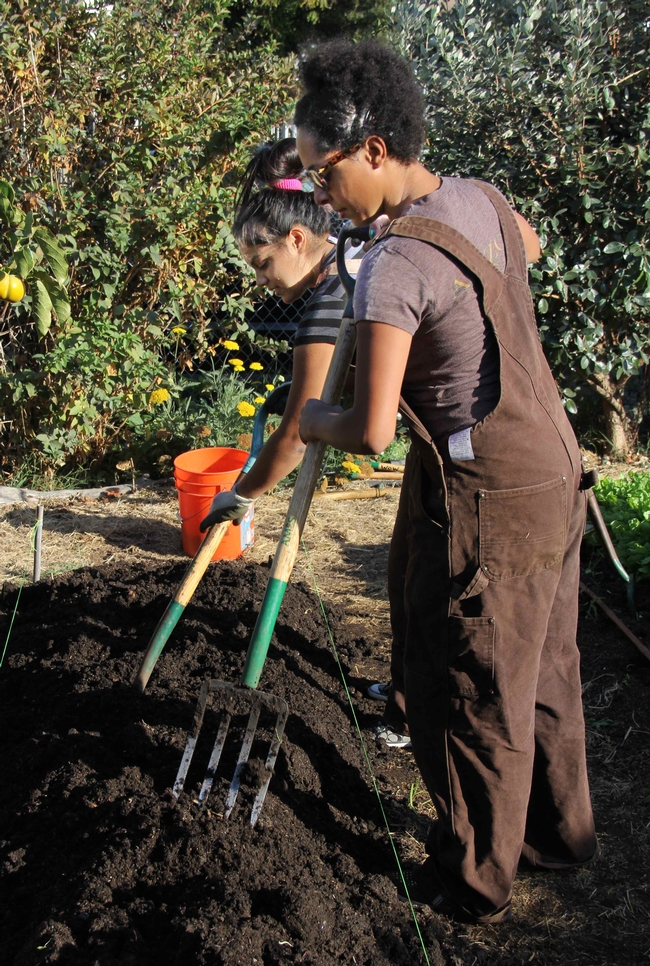Does Urban Agriculture Improve Food Security?
A newly published literature review in the Journal of Sustainability conducted by a team of Berkeley Food Institute researchers has found that while many studies cite the potential food security benefits of urban agriculture (UA), there are few that robustly measure the impact of urban farms on improving food security in low-income communities. Results of this review are guiding a three-year research project, funded by the Foundation for Food and Agriculture Research and the Berkeley Food Institute to investigate and address urban food access challenges in the eastern region of the San Francisco Bay Area, where interest in UA abounds, yet levels of gentrification, food insecurity, and income inequality are growing.
Without understanding the actual links between UA and food security or which specific characteristics, models or approaches reduce insecurity, urban policymakers and advocates risk backing policies that could have unintended consequences or negative impacts on vulnerable individuals and communities. We argue that in addition to more robust analyses that measure the actual social, economic, and health impacts of urban agriculture, and how they impact food security, it is important to understand which approaches to policy, governance and civic engagement support UA models that are effective in reducing food insecurity.
In general, we see three trends in current scholarship on UA in relation to community food security: (1) a focus on the production potential of urban lands, (2) individual case studies highlighting various nutritional, health, and other community benefits or outcomes from urban gardening initiatives, and (3) more critical analyses of UA through food justice and equity lenses. To this latter point, robust theoretical analyses have emerged critiquing the risks of UA when approached without an equity lens, potentially reinforcing structural injustices and racism and negatively impacting communities that ideally should benefit the most.
Deeper historical and structural challenges including poverty, racism, and divestment in specific communities and neighborhoods are increasingly being recognized as the root causes of the problem of unequal access to sufficient supplies of safe, nutritious, affordable, and culturally acceptable food facing cities. Designating land for agricultural use in urban areas may conflict with other city planning priorities around affordable housing, community economic development, or smart growth approaches associated with reducing urban sprawl and mitigating climate change, such as transit-oriented development. Because of the persistent legacy of systemic discrimination, it is neither inevitable nor guaranteed that urban agriculture will redress food system inequities; in fact, urban farms can sometimes lead to displacement through eco-gentrification. This is a particularly acute concern in areas experiencing housing pressures and population growth, such as the San Francisco Bay area and New York City.
Analyzing the intersection of food access and food distribution literatures reveals three key factors mediating the effect of UA on food security in the urban food system:
(1) the economic viability of urban farms (to sustain the provisioning of affordable urban produced foods)
(2) the role of city planning and policies in advancing racial equity through UA such as secure land tenure and public investment, and
(3) the importance of civic engagement to advocate for and hold cities and counties accountable to the needs of low-income communities.
We highlight examples from both the scholarly and gray literatures that demonstrate how UA can improve food access, distribution, and justice, in a way that supports both consumers and producers of food in cities. The gray literature in particular reveals many emerging and informal distribution networks for urban produced foods that would benefit from further academic study, such as gleaning networks, distribution apps, and online platforms.
The review concludes with a set of recommendations for researchers, practitioners, and policymakers who seek to create spaces in cities for food justice, equity, access, and sovereignty. Most notably we acknowledge that urban farms are producing a lot more than food; and that equitable planning, public investment and civic engagement are crucial elements in securing the long-term viability of urban farms. More robust analyses documenting the multifaceted benefits and risks of UA such as public health, food security, youth development, food literacy, eco-gentrification and environmental justice can help inform more equitable public policy and planning efforts.



